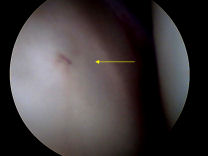Glenoid Bare Area
at the centre or proximal to the centre of the glenoid, “…an area of cartilage thinning and increased subchondral density” can be seen [figure 4]. [16-17] this bare area or area of cartilage thinning is an acquired lesion or may be a developmental variant. [16-17]
in an mr imaging study, ly et al [16] reviewed the notes of 3 patients with a bare area and reported it to be “…a smoothly marginated subcentimeter area of thinning of the central articular cartilage…” they hypothesised the possibility of the bare area being a developmental variant because of the young age of the patients reviewed (19-32 years old). [16] however, with such a smaller number of patients and a narrow age range, it is not possible to say conclusively that it is a developmental variant. in order to prove this hypothesis, a greater number of patients from a wider age range would need to be reviewed.
arthroscopically, this bare area has a “…slightly blue appearance”, [10] “…may show superficial fibrillations…” [1] and should not be confused with chondromalacia. [6]

figure 4 – arthroscopic image of the glenoid bare area (arrow). this is “…an area of cartilage thinning and increased subchondral density” situated at the centre or proximal to the centre of the glenoid fossa. [16-17] it may be an acquired lesion or a developmental variant. [16-17]
in our study:
a bare area was found in 22.7% of cases. a medium-sized bare area (diameter - 5 to 10mm) was most commonly encountered. no other study has commented on the prevalence or the size of the glenoid bare area. however, without the aid of a measurement tool and the occasional poor visualisation at arthroscopy, classifying the sizes was sometimes difficult.
in a mr imaging study, ly et al [14] hypothesised the possibility of the bare area being a developmental variant because of the young age of the patients reviewed (19-32 years old) in their study. however, because of insufficient number of patients below 30 years of age (1 patient in our study), this hypothesis cannot be commented on.
 medium-sized bare area
medium-sized bare area


